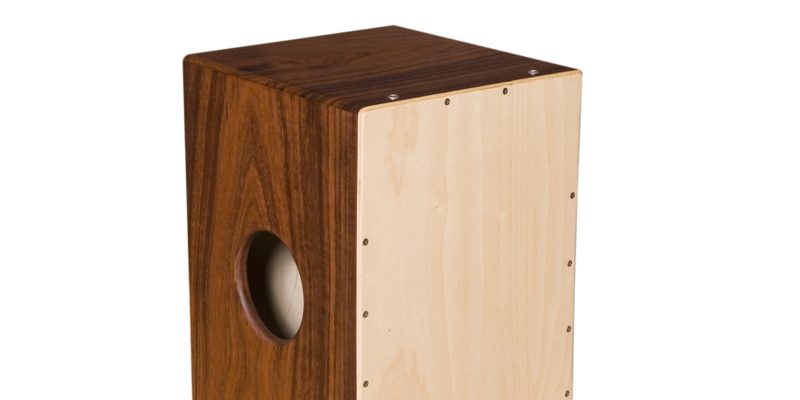Cajon drums or drum boxes have been in the spotlight for the past few decades and have a nice number of users around the world.
This is mostly because of their versatility. As they offer a smooth and dry sound, are easy to transport and can even be comfortable to sit on, these instruments made their way to professional and amateur drummers and percussionist’s inventories in almost all music styles.
And yes, that includes hip-hop. But…
What exactly is a cajon drum?
Although there are several variations, just like for any other instrument, a cajon or box drum consists of a wooden or hardened box with open spaces or mouths that allow the sound to get out. Usually, these drums have rectangular shape, with the exception of some models with the wood of superior class, normally of birch or beech plywood.
It was invented in Peru and mentioned for the first time in writing in the mid-19th century.
However, its origins take us back two centuries ago, when African slaves were not allowed to play the drums, and they had to find something to replace their instruments. From what we know, the first drum box was made of fruit box.
It was in the late 70’s that the legendary flamenco guitarist De Lucia made this instrument popular. And later on with the hit of “MTV Unplugged” its use extended to pop music.
Today, the drum box features in almost every music style, from flamenco to metal, hip-hop, and pop.
Variations
There are many types of cajons out there, and, as this instrument’s base design is quite simple, it can be modified and personalized easily by any crafter who manages to create a new sound with it. Before we go further with all the different types of the instrument, you might want to check out the current top choices of cajons so you can get a better grasp of the whole instrument and its development.
But, to narrow it down a bit; ahead we talk about the most popular cajon drums and how they offer different types of sound.
Peruvian
The Peruvian cajon, that original first model of the drum box, is just basically that, a wooden box whose void creates a drum sound which varies depending on which part of the surface is being hit. These have no snare system, which means that there are no strings attached to interrupt the depths of the sound, and the corners of the surface are usually sealed with leather or a thinner layer of wood.
These cajons require great technique in order to control the sounds generated and are in essence harder to use if the music requires maintaining the type of sound while changing the rhythm.
Flamenco
After the 70’s when Paco De Lucia and Ruben Dantas took Peruvian drum boxes into their bands, the instruments quickly became a base sound for Flamenco.
But, differently from the Peruvian typical music, flamenco has the peculiarity of harmonic guitar picking in fast speeds, needing a base sound that felt lighter, more like a rattle. Subsequently, thin guitar strings were added to the box to create the resonance of that sound, giving birth to flamenco cajon.
This type of drum box is particularly popular for its clear response and a rather dry sound, with the separation of bass and treble within Latin music, especially danceable music like salsa, merengue, and of course flamenco.
With Snare
Now, the snare cajon is the hip and younger brother of the other drum box types, this type is designed with a snare system that accentuates the box’s sound and allows the drummer to add special effects – depending on the model.
These use a snare system added to the cajon with actual snare wires – like in a snare drum – instead of just adding guitar strings to cross the sound.
As it tends to happen with newer instruments, there are many variations of this type of drum box, including an on-off switch for the snare system, and electronic plugs and kick plugs.
The snare cajon is more common in modern Latin music, but its sound is so versatile that it fits perfectly with soft rock, hip-hop, and pop music.
Cuban
Cuban cajons are meant for Son and Salsa and are frequently used in many other Caribbean styles.
They are different in design, consisting of a five-sided box that the musician sets between his legs and uses to play.
These count with a more natural and clear sound, often needing an amplifier system when used in the open or noise-full spaces.
Cajon drum in Hip-Hop
As a hip-hop musician, innovation is a deal maker – the more unique and cool your sound is, the more chances you have of making a hit among the genre’s fans.
About this, using a cajon drum is more of a dare – you would need an experienced musician, able to maintain the rhythm changes while kicking the drum’s beat as a base for the bass and melody instruments to ride on.
If staging, a snare cajon is the best option to deal with this, but if you are thinking of buying a cajon for hip-hop street performances, the hard Cuban will offer a more versatile and variable sound, with smooth deep beats.
This instrument is a nice fit for every drummer’s set, but due to the variety in the style of their sound, they are harder to play than another round percussion instruments. If you’re up to the task, consider first the type of sound you are looking for and find the drum box that better fits with your style.
We hope that this information was useful to you, use the comment section below to let us know what type of cajon box you have used and how the sound fits your music.


Great article. I’m looking to get one as a gift. Any recommendations of where to get one?